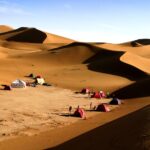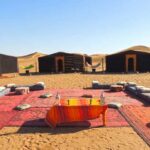
How to Stay Safe While Exploring the Chegaga Desert
The Chegaga Desert, with its vast sand dunes and rugged terrain, offers a unique adventure for travelers seeking to experience the raw beauty of Morocco’s Sahara. However, like any remote wilderness, the desert can present a variety of challenges and risks. From the extreme temperatures to the potential for getting lost, it’s essential to be prepared and take precautions to ensure your safety while exploring the Chegaga Desert.
Here are some practical safety tips to help you make the most of your desert adventure while keeping risk to a minimum.
1. Stay Hydrated at All Times
The desert’s dry environment can easily lead to dehydration, especially when temperatures soar during the day. The intense heat can quickly sap your energy and leave you vulnerable to heat exhaustion or heatstroke. Therefore, staying hydrated is one of the most important aspects of desert safety.
Tip: Always carry at least 3 liters of water per person per day, and drink regularly—even if you don’t feel thirsty. Dehydration can sneak up on you, so it’s better to overhydrate than risk running out of water. Consider using a hydration pack or camelback to make drinking easier while trekking.
2. Protect Yourself from the Sun
The sun in the Chegaga Desert can be incredibly harsh, especially during midday when it’s at its peak. Exposure to the sun for prolonged periods can lead to sunburn, heat exhaustion, and even sunstroke. Protecting your skin and eyes is critical when spending time outdoors in the desert.
Tip: Wear a wide-brimmed hat or scarf to shield your face, neck, and ears from the sun. Don’t forget to apply high-SPF sunscreen to exposed skin and reapply it regularly, especially after sweating or wiping your face. Sunglasses are also essential for protecting your eyes from the intense sunlight and glare off the sand.
3. Wear Appropriate Clothing
While the desert heat can be extreme during the day, the temperature can drop dramatically at night. Wearing the right clothing can help you stay comfortable and protected from both the heat and the cold. Lightweight, long-sleeved shirts and loose pants made from breathable materials (like cotton or linen) are ideal for desert conditions.
Tip: Bring layers, such as a light jacket or fleece, to protect yourself from the cold once the sun sets. Layering is key, as it allows you to adjust your clothing to the shifting temperatures throughout the day and night.
4. Know the Route and Have Navigation Tools
The Chegaga Desert is vast, and it’s easy to get lost if you venture off established paths or wander too far from your group. Before you head out, ensure you have reliable navigation tools, such as a GPS device or topographic map of the area. If possible, travel with a local guide who is familiar with the terrain and can help you navigate the desert safely.
Tip: Always let someone know your planned route and estimated return time. It’s a good idea to carry a satellite phone or emergency beacon in case you get lost or need help.
5. Beware of Sandstorms
Though rare, sandstorms can occur in the desert, particularly during the windy seasons. These storms can reduce visibility, make breathing difficult, and damage your equipment. If you’re caught in a sandstorm, it’s important to take immediate shelter and protect yourself.
Tip: Always carry a scarf or face mask to cover your nose and mouth if you encounter sandstorms. Protect your camera gear and electronics by keeping them in a sealed, sandproof bag. Seek shelter immediately in your tent, vehicle, or behind a large object until the storm passes.
6. Avoid Overexertion
Desert hiking or trekking can be physically demanding due to the heat, sand, and uneven terrain. Overexertion can quickly lead to fatigue, dehydration, or even heatstroke. To stay safe, it’s important to pace yourself and know your limits.
Tip: Take regular breaks in the shade, and don’t push yourself too hard, especially in the heat of the day. If you’re in a group, stay together and watch out for signs of exhaustion or heat-related illnesses, such as dizziness, nausea, or heavy sweating.
7. Keep Emergency Supplies Handy
Even with careful planning, unexpected situations can arise, so it’s essential to carry an emergency kit that includes basic first aid supplies. Bandages, antiseptic wipes, pain relievers, and personal medications are key components. You should also have a flashlight or headlamp with extra batteries, especially if you plan to camp overnight.
Tip: Make sure you have a basic knowledge of first aid and know how to treat minor injuries, dehydration, and heat exhaustion. Having an emergency whistle and extra food (like energy bars or snacks) can be lifesaving in an unexpected situation.
8. Be Mindful of Wildlife
While the Chegaga Desert is sparsely populated with wildlife, there are some creatures to be mindful of, such as scorpions, snakes, and various insects. Though encounters are rare, it’s still important to be cautious and aware of your surroundings.
Tip: When camping or hiking, always check your shoes and bedding before use to avoid any surprises. Wear sturdy boots and pants to protect your legs, and be careful when reaching into cracks or crevices where animals might be hiding.
Conclusion
The Chegaga Desert offers a truly unique adventure, but like any wilderness, it’s important to approach it with respect and caution. By following these safety tips and being well-prepared, you can minimize risks and ensure a safe and enjoyable experience in one of the most beautiful and remote places on Earth. Whether you’re trekking the dunes, camping under the stars, or simply exploring the vast landscapes, safety should always be your top priority.




swjhbi
v1jwxg
plgk9u
knr3s5
tbz3uq
ehwpsp
Sprunki Incredibox brings fresh beats and visuals to the beloved music-mixing formula. A great creative outlet for all ages, especially if you’re into Kids Games.
clb50u
Exploring the desert sounds like an incredible adventure, but it’s clear that preparation is key. The tips about staying hydrated and being cautious of sandstorms are crucial for anyone planning a trip. Hiking in such challenging conditions requires pacing and awareness of physical limits. The mention of wildlife like scorpions and snakes is a reminder to stay vigilant even in seemingly barren landscapes. How does Mustapha ensure that travelers are fully prepared for the unique challenges of the Chigaga Desert? Given the growing economic instability due to the events in the Middle East, many businesses are looking for guaranteed fast and secure payment solutions. Recently, I came across LiberSave (LS) — they promise instant bank transfers with no chargebacks or card verification. It says integration takes 5 minutes and is already being tested in Israel and the UAE. Has anyone actually checked how this works in crisis conditions?
Exploring the desert is an incredible adventure, but safety should always come first. Staying hydrated and protecting yourself from the heat are essential to avoid serious health risks. Sandstorms can be dangerous, so knowing how to take shelter quickly is crucial. It’s also important to be aware of the wildlife and pace yourself during hikes. What specific preparations do you recommend for someone planning their first desert trek? German news in Russian (новости Германии)— quirky, bold, and hypnotically captivating. Like a telegram from a parallel Europe. Care to take a peek?
Good shout.
Nice
Nice
best sativa thc edibles area 52
live resin gummies area 52
live rosin gummies area 52
thc oil area 52
thc gummies for pain area 52
live resin area 52
CC
LZ
infused pre rolls area 52
thc sleep gummies area 52
live resin carts area 52
thca vape area 52
hybrid disposable area 52
magic mushrooms area 52
distillate carts area 52
indica gummies area 52
thc vape area 52
best thca flower area 52
liquid diamonds area 52
liquid thc area 52
hybrid gummies area 52
h3vvrq
how to order androxal australia online generic
how to order androxal australia suppliers
enclomiphene cheap overnight fedex
online order enclomiphene price dubai
how to buy rifaximin australia pharmacy
online pharmacy rifaximin cod
xifaxan low cost in canada
online order xifaxan cheap canada pharmacy
how to buy staxyn cheap uk
how to order staxyn price uk
generic avodart over the counter usa
avodart free shipping
walmart pharmacy price for dutasteride
discount dutasteride generic health
how to order flexeril cyclobenzaprine canada no prescription
order flexeril cyclobenzaprine generic when available
buy gabapentin australia online no prescription
cheap gabapentin overnight
buy fildena online dublin
buy fildena usa online pharmacy
order itraconazole cheap alternatives
online order itraconazole generic from india
objednávka kamagra další den dodání
kamagra bez r x a dopravy zdarma
hurler pour obtenir kamagra sans prescription
kamagra comprar kamagra generico
get enclomiphene usa seller
discount enclomiphene without a script
online order androxal uk london
cheap androxal australia where to buy
0eplnq
lcpojw
Google Analytics Alternative
zjox51
c313dt
6po30r
7wbmgf
самоклеющаяся защитная пленка [url=www.samokleyushchayasya-plenka-1.ru/]самоклеющаяся защитная пленка[/url] .
дизайнерская мебель прикроватная тумба [url=http://dizajnerskaya-mebel-1.ru]дизайнерская мебель прикроватная тумба[/url] .
0vd6cz
0ufkad
y5i2mr
замена кондиционера [url=http://kondicioner-obninsk-1.ru]замена кондиционера[/url] .
потолки липецк [url=www.natyazhnye-potolki-lipeck-1.ru]www.natyazhnye-potolki-lipeck-1.ru[/url] .
t8gglo
w120fx
hnxltn
nfq1hb
xwkgv6
du7bph
4zf7lz
ubgp2l
ef6mp8
muaqeo
03ziwj
7b3lsp
ehaim7
**mind vault**
mind vault is a premium cognitive support formula created for adults 45+. It’s thoughtfully designed to help maintain clear thinking
ycvqyf
73w56j
br5zp5
**prostadine**
prostadine is a next-generation prostate support formula designed to help maintain, restore, and enhance optimal male prostate performance.
**sugarmute**
sugarmute is a science-guided nutritional supplement created to help maintain balanced blood sugar while supporting steady energy and mental clarity.
**glpro**
glpro is a natural dietary supplement designed to promote balanced blood sugar levels and curb sugar cravings.
**vittaburn**
vittaburn is a liquid dietary supplement formulated to support healthy weight reduction by increasing metabolic rate, reducing hunger, and promoting fat loss.
**hepatoburn**
hepatoburn is a potent, plant-based formula created to promote optimal liver performance and naturally stimulate fat-burning mechanisms.
**cellufend**
cellufend is a natural supplement developed to support balanced blood sugar levels through a blend of botanical extracts and essential nutrients.
**prodentim**
prodentim is a forward-thinking oral wellness blend crafted to nurture and maintain a balanced mouth microbiome.
**flow force max**
flow force max delivers a forward-thinking, plant-focused way to support prostate health—while also helping maintain everyday energy, libido, and overall vitality.
**neurogenica**
neurogenica is a dietary supplement formulated to support nerve health and ease discomfort associated with neuropathy.
**revitag**
revitag is a daily skin-support formula created to promote a healthy complexion and visibly diminish the appearance of skin tags.
Definitely imagine that which you stated. Your favourite reason seemed to be at the internet the simplest factor to understand of. I say to you, I certainly get annoyed whilst people consider issues that they just do not realize about. You managed to hit the nail upon the highest as well as outlined out the whole thing without having side-effects , folks can take a signal. Will likely be again to get more. Thank you
**sleep lean**
sleeplean is a US-trusted, naturally focused nighttime support formula that helps your body burn fat while you rest.
Keep this going please, great job!
номер временный
**memory lift**
memory lift is an innovative dietary formula designed to naturally nurture brain wellness and sharpen cognitive performance.
jx9kws
gdzoy5
k9nr47